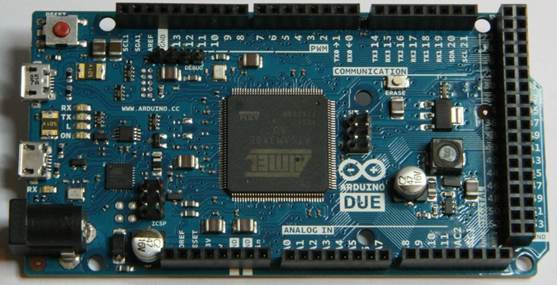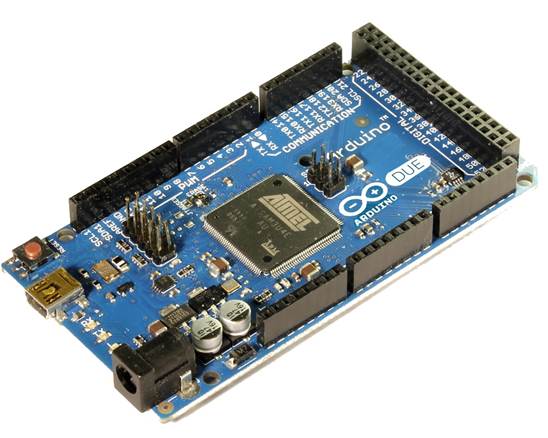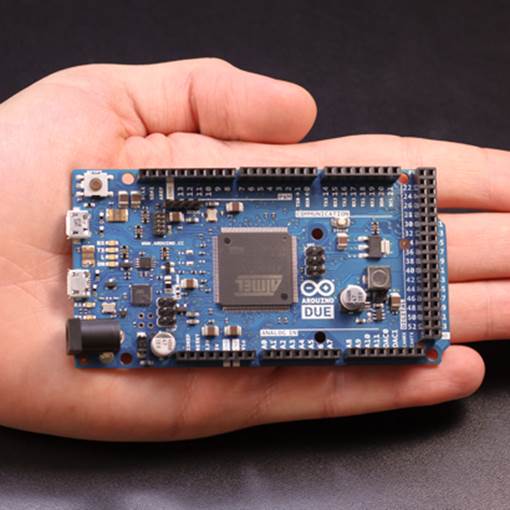Can Arduino’s new micro controller
board bring ARM’s power to the masses? Ben E. investigates
Arduino has made a name for itself by
producing micro controller boards that are simple and easy to use. Up until no,
it has stuck with AVR-based processors. However, in the past eight years things
have moved on in the silicon world, and some users are abandoning AVR for the
more powerful ARM-based chips. We’ve got our hands on the first Arduino board
to use the more powerful micro controllers.

Arduino
has made a name for itself by producing micro controller boards that are simple
and easy to use
Let’s start with the bad news. Unlike
previous boards from Arduino, the Due uses 3.3 volts, and isn’t 5-volt
tolerant. This means it’s incompatible with some Arduino shields, and may not
work with circuits designed for other boards. Not only that, but it could turn
to toast if you try to use it in a way you would with a different Arduino. This
simple fact means that the Due isn’t a board for beginners, it’s a board for
people who like Arduino and need the power of ARM.
Not all ARM chips are the same, though, and
this isn’t an all-singing all-dancing SoC, like the one in the Raspberry Pi.
Instead, it’s an ARM micro-controller, so you program it with one program,
using the Arduino IDE that it then runs. The extra power of the ARM chips gives
you a whole host of new features, any of which could be considered ‘killer’
depending on your project:
·
Increased processing power, courtesy of a cortex
M3 running at 84MHz
·
Two USB ports (one for programming, one for
normal use) make developing for this kind of connectivity far easier
·
A scheduler, so that you can run multiple tasks
·
Two digital to Analogue Converters (DACs,
12-bit) to enable you to control analogue devices. For example, you can play
music through a speaker directly connected to the board
It’s compatible with the Android ADK,
enabling you to use it to develop peripherals for Android phones and tablets
This obviously represents a big step up
from the AVR Arduinos, but micro-controllers aren’t about processing power or
feature bloat. In general, the best micro-controller for the task is the one
that has just what you need and no extra bloat.
The next level

The
Due is slightly bigger than the Uno, and packs a much bigger punch
To use the Due, you’ll need to install the
Arduino IDE version 1.5 or later. Most distro’s repositories are still at
version 1, so you’ll need to get it manually. We found that this was as simple
as unzipping The Tarball and running the executable (no./configure &&
make && sudo make install necessary).
The Uno and Mega are still the best boards
for beginners, and this isn’t likely to change soon. The added features of the
Due just aren’t needed for almost all beginner’s projects, and the
compatibility and support for the older boards is worth far more than unused
abilities. However, the Due has just made several classes of project a whole
lot easier and cheaper (because you’ll need fewer additional components).

The
Uno and Mega are still the best boards for beginners, and this isn’t likely to
change soon.
Here at LXF Towers, we’re most excited
about the DACs and the two USB ports, but that’s just us. We’re sure the
blogosphere will soon be full of Dues powering all sorts of contraptions big
and small.
If you’re planning an ambitious project, a
Due should be on your shopping list.
|
Arduino Due
Specifications
§ Microcontroller:
AT91SAM3X8E
§ Operating
voltage: 3.3V
§ Recommended
input voltage: 7-12V
§ Input
voltage limits: 6-20V
§ Digital
I/O pins: 54 (of which 12 provide PWM output)
§ Analog
input pins: 12
§ Analog
outputs pins: 2 (DAC)
§ Total
DC output current on all I/O lines: 130mA
§ DC
current for 3.3V pin: 800mA
§ DC
current for 5V pin: 800mA
§ Flash
memory: 512KB all available for the user applications
§ SRAM:
96KB (two banks: 64KB and 32KB)
§ DataFlash:
2Mb (250KB)
§ Clock
speed: 84MHz
Verdict
§ Developer:
Arduino
§ Price:
$51
§ Ratings:
9/10
|